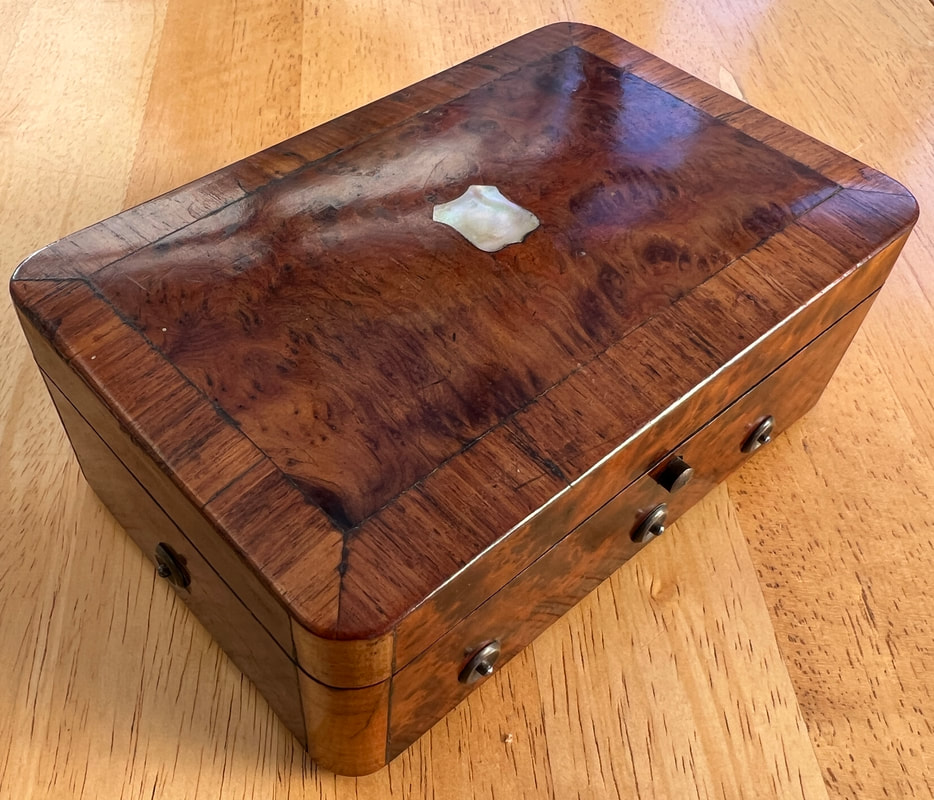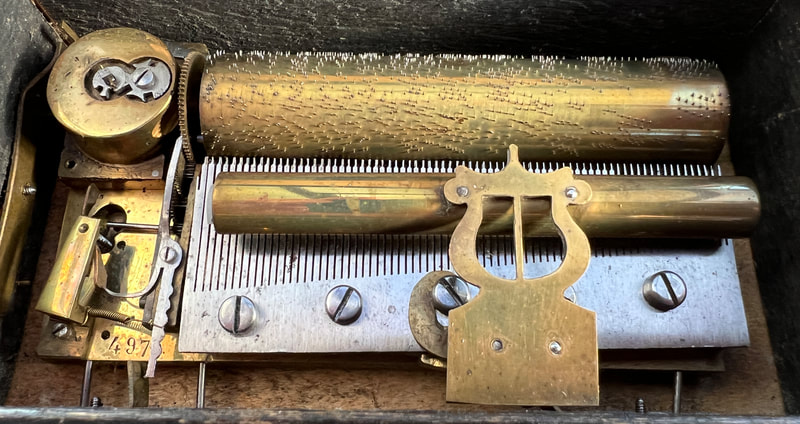4/77 Mandoline Zither Tabatiére circa 1890 - Serial No. 4976
Bought at auction January 2024
A very unusual and rare Tabatiére Mandoline Zither in a beautiful Amboyna case and with a pristine tune sheet.
Originally retailed by C Scotcher & Sons, Musical Box Importers, 36 Bull Street, Birmingham.
Hardly a mark on the case or movement, though there are just a few pins that need straightening.
Described as being made circa 1870 but research shows one tune as being composed in 1889 so 1890 is a more likely date.
A very unusual and rare Tabatiére Mandoline Zither in a beautiful Amboyna case and with a pristine tune sheet.
Originally retailed by C Scotcher & Sons, Musical Box Importers, 36 Bull Street, Birmingham.
Hardly a mark on the case or movement, though there are just a few pins that need straightening.
Described as being made circa 1870 but research shows one tune as being composed in 1889 so 1890 is a more likely date.
Possibly made in Sainte Croix by Paillard who invented the zither in about 1886.
Tune sheet hitherto unknown so maker still unsure.
Tune sheet hitherto unknown so maker still unsure.
Tune 1
Le jet d'Eau - One of five 'Cinq poemes' written by Charles Baudelaire. They constitute a song cycle for voice and piano by Claude Debussy on poems taken from Les Fleurs du Mal
Le Jet d'Eau was finished in March 1889
Le jet d'Eau - One of five 'Cinq poemes' written by Charles Baudelaire. They constitute a song cycle for voice and piano by Claude Debussy on poems taken from Les Fleurs du Mal
Le Jet d'Eau was finished in March 1889
|
Without Zither
|
With Zither
|
Tune 2
The Carnival of Venice is based on a Neapolitan folk tune called "O Mamma, Mamma Cara" and popularized by violinist and composer Niccolo Paganini, who wrote twenty variations on the original tune. He titled it "Il Carnevale Di Venezia," Op. 10. In 1829, he wrote to a friend, "The variations I've composed on the graceful Neapolitan ditty, 'O Mamma, Mamma Cara,' outshine everything. I can't describe it."
The Carnival of Venice is based on a Neapolitan folk tune called "O Mamma, Mamma Cara" and popularized by violinist and composer Niccolo Paganini, who wrote twenty variations on the original tune. He titled it "Il Carnevale Di Venezia," Op. 10. In 1829, he wrote to a friend, "The variations I've composed on the graceful Neapolitan ditty, 'O Mamma, Mamma Cara,' outshine everything. I can't describe it."
|
Without Zither
|
With Zither
|
Tune 3
Victoria Grande Valse was written for piano by Jules Schulhoff in 1846. Originally titled Grande valse brilliant, Op.6
Victoria Grande Valse was written for piano by Jules Schulhoff in 1846. Originally titled Grande valse brilliant, Op.6
|
Without Zither
|
With Zither
|
Tune 4
Home Sweet Home is a song adapted from American actor and dramatist John Howard Payne's 1823 opera Clari, or the Maid of Milan. The song's melody was composed by Englishman Sir Henry Bishop with lyrics by Payne. Bishop had earlier published a more elaborate version of this melody, naming it "A Sicilian Air", but he later confessed to having written it himself.
Home Sweet Home is a song adapted from American actor and dramatist John Howard Payne's 1823 opera Clari, or the Maid of Milan. The song's melody was composed by Englishman Sir Henry Bishop with lyrics by Payne. Bishop had earlier published a more elaborate version of this melody, naming it "A Sicilian Air", but he later confessed to having written it himself.
|
Without Zither
|
With Zither
|
The burning question is "do you prefer the tunes with, or without, the zither?




